





•
•
•














•
•
•







CEO Michael Shepard
VICE PRESIDENT OF CONTENT Leon Espinoza
EDITORIAL DIRECTOR Mike Teegarden, CCC
DEPUTY EDITORIAL DIRECTOR
Noble Sprayberry
SENIOR EDITOR Jennifer Paton, CCC
FLORIDA CURRENTS EDITORS
Chasity Anderson, CCC; Valeri Pearon
ASSISTANT EDITORS Victoria Hampton, CCC; David Herder, CCC
ASSOCIATE EDITOR
Nina Todea
PUBLICATIONS PRODUCTION MANAGER
Elizabeth Beatty
PUBLICATIONS COORDINATOR
Alyssa McDougle
Members acknowledge that $4.31 a year, plus postage, is the cost to publish 12 issues a year of FLORIDA CURRENTS ISSN 23276304 (USPS 8300). Published by Pioneer Utility Resources Inc., 5625 NE Elam Young Pkwy. Ste. 100, Hillsboro, OR 97124—a not-for-profit Oregon cooperative corporation—the magazine serves the communication needs of consumerowned electric utilities in Florida. Preferred Periodicals postage paid at Hillsboro, OR 97123 and at additional mailing offices.
Postmaster: Send address changes to 5625 NE Elam Young Pkwy., Ste. 100, Hillsboro, OR 97124-6422.
HOW TO CONTACT FLORIDA CURRENTS
Subscription services:
Nonmember subscriptions $15 U.S. a year; $25 foreign a year. Prepayment required. Allow 4-8 weeks for first issue. Identify local edition desired. Have a problem receiving your magazine? Utility members should contact their utility office. Nonmembers call 503-357-2105 or email mailingdept@pioneer.coop.
Back issues:
Back issues and extra copies are $3 each, prepayment required. Supply is limited. Identify edition, month and year. Call first to check availability. Contact Pioneer Utility Resources: P.O. Box 1306, North Plains, OR 97133-1306; 503-357-2105; email: mailingdept@pioneer.coop.
DISPLAY ADVERTISING INQUIRIES
American MainStreet Publications 611 S. Congress Ave. Ste. 504 Austin, TX 78704-1714; 800-626-1181 or 512-441-5200; amp.coop.
© 2024 Pioneer Utility Resources. All rights reserved. Reproduction in whole or in part without written permission is prohibited. Direct reprint requests to editor@floridacurrents.com For more information, visit www.pioneer.coop.

For additional content, search @FloridaCurrents on your favorite social media sites and floridacurrents.com.




Sea Urchin Nursery Florida Keys research may help protect Caribbean reefs Up Close, Page 10
In the Game Esports growth offers Florida students community and opportunity Spotlight, Page 12


Story and photos by McKenzie Miller
Christmas is the most magical time of the year for children. The annual Marine Toys for Tots Christmas toy drive is a meaningful fundraiser for children who would not otherwise receive presents.
Each year, funds are raised and toys are bought for less fortunate children to give them the best Christmas possible.
The Toys for Tots program began in 1947 by Maj. Bill Hendricks, with the support of fellow members of the U.S. Marine Corps Reserve. This program is supported by the Marine Corps Reserve and through donations and hardworking volunteers.
Celebrities such as John Wayne, Garth Brooks, Tim Allen, Brooke Shields and Billy Ray Cyrus have devoted time and talent to support this organization.
After 11 years of dedication to the organization, Coordinator Joseph Hosick retired from MT4T in Hendry and Glades counties. This past Christmas, MT4T in Hendry and Glades counties were divided into separate campaigns, each with its own coordinators.
Margaret English and Nardina Johnson were selected as the coordinators for Hendry County, and Rashondra Croskey has been selected as the coordinator for Glades County.
“As one of the coordinators for Toys for Tots, this program means so much to me,” Glades County Coordinator Rashondra says. “Many kids go without Christmas toys or even celebrating Christmas. This organization makes sure that all kids receive a nice toy for Christmas.”
MT4T makes an average of 7.4 million children’s Christmas extra special.
In 2022, MT4T Hendry and Glades counties served a total of 3,053 children, distributing 5,804 toys, 2,004 stocking stuffers and 2,077 books, averaging 2.26 gifts per child.
The gifts are accumulated into the designated warehouse and sorted by age. Once it’s time for pick up, the unwrapped toys are given to the parents who wrap them and gift them to their children on Christmas morning.
Not only is this a special moment for the children but also for the parents who are able to gift the toys and take part in making Christmas memorable for their children.
Thanks to the generosity of members who participate in Glades Electric’s Operation Round Up, Toys for Tots received $4,000 in support from the Glades Electric Charitable Trust, with $1,500 awarded to MT4T Hendry and $2,500 to MT4T Glades.
“I am honored and grateful that the Glades Electric Charitable Trust was so kind to donate funds to help us buy toys for these children in need,” Rashondra says. “Because of this donation, we are able to put smiles on the faces of kids in need this holiday season.”
When Glades Electric Cooperative members elect to round up their electric bill to the next dollar, grants are possible for local nonprofits and members in need. The mission of Operation Round Up is

to improve the quality of life in the local communities GEC serves.
If you would like to enroll in ORU and help make a difference in your community, sign up through the SmartHub app, our website, by checking the enrollment box on the back of your bill, or by calling member services at 863946-6200. Member services hours are 7 a.m. to 6 p.m. Monday through Thursday.
Your small change can help make a big difference.






Glades Electric’s wholesale power provider, Seminole Electric Cooperative, hosted a ribbon-cutting ceremony September 13 in Putnam County, Florida, to celebrate its new generating facility, the Seminole Combined-Cycle Facility.
“Seminole has benefited its member cooperatives and Putnam County for decades,” says Susan Reeves, Seminole Board president and Clay Electric District trustee. “Seminole started as a paper generation and transmission cooperative in 1948. Today, Seminole is one of the largest generation and transmission cooperatives in the country, and we are here to celebrate its continued growth.”
“I am so proud of Seminole, our Putnam County community and our board for working together to accomplish this project,” Seminole CEO and General Manager Lisa Johnson says. “Seminole’s commitment to this community and all the communities we serve is to be safe, reliable, affordable and responsible. With the addition of SCCF, Putnam County now has one of the most efficient natural gas combined-cycle power plants in the world.”
High efficiency means the plant can make more electricity while burning less natural gas, saving member-consumers money on their electric bills. Additionally, SCCF has a rated capability of more than 1,100 megawatts and occupies a small

footprint of less than 20 acres.
Approximately 140 people attended the ribbon-cutting, including local and state dignitaries; Seminole’s member electric cooperatives; Glades Electric Cooperative CEO Jeff Brewington and trustees Jack Coxe, Lee Henderson, Donnie Lundy, Mike Pressley and Fred Tagtmeier; and Seminole employees. n
Seminole is one of the country’s largest generation and transmission cooperatives. Its purpose is to provide essential wholesale services to its members through a balanced, diversified portfolio of safe, affordable, responsible and reliable energy resources.

Seminole and its nine distribution cooperative members collectively serve 1.9 million individuals and businesses in 42 Florida counties. Seminole’s headquarters are in Tampa, Florida. For more information, visit www.seminole-electric.com.

*Projections are based on current model assumptions in Seminole’s 2023 10-year site plan and are subject to change.

Ringing in a new year sparks a sense of renewed hope and optimism about the future. It’s a time to reflect on where we are and where we’re going. At the heart of this reflection, we think about ways we can better serve you, the members.
The Glades Electric Cooperative team is looking ahead, exploring ways to innovate and use new technologies to improve our services.
As our nation increasingly relies on electricity to power the economy, keeping the lights on has never been more important. We’re committed to powering—and empowering—our community at a cost local families and businesses can afford.
How are we working to ensure reliable and affordable power while adapting to a changing energy landscape and our community’s needs?
One critical component of reliable power is the mix of energy resources used to generate the electricity that keeps the lights on across Florida’s Heartland.
You may not realize it, but Glades Electric doesn’t generate electricity. We buy electricity from our energy provider, Seminole Electric Cooperative, and distribute it to homes and businesses throughout the community.
A vast majority of Seminole’s energy resources in 2023 came from natural gas and coal, estimated at about 48% and 35%, respectively.
We’re planning to use more electricity generated from renewable energy sources, but we still depend on a diverse energy mix to ensure reliable power that’s available to members whenever they need it.
In addition to managing that energy mix, GEC uses technology to enhance its local grid, limit service disruptions and improve outage response times.
Advanced metering technology (AMI) enables two-way communication between the co-op and consumers.
In the event of a power outage, AMI helps pinpoint the location of the outage and can identify damaged or tampered meters. AMI helps the co-op save money with real-time data, and it ultimately improves power reliability for the entire community.
Proactive tree trimming is another way we limit service disruptions.
Scheduled trimming keeps power lines clear from overgrown limbs.
As technological advancements become more accessible, we anticipate using advanced mapping software to better maintain the environment while providing more reliable service.
GEC is building a high-speed fiber network to serve members and enhance infrastructure. In time, this network will enable smart grid capabilities consisting of controls, computers, automation, and new technologies and equipment that will work together to respond digitally to events on the grid. This enables faster restoration and better resiliency.
One of the best methods for improving our services is monitoring trends and leading practices from other electric co-ops across the country.
Learning from other co-ops is one of the benefits of the cooperative business model because for us, it’s about cooperation, not competition.
As we turn our focus to 2024, Glades Electric will continue working to provide the reliable, affordable electricity you expect and deserve—for today and tomorrow.



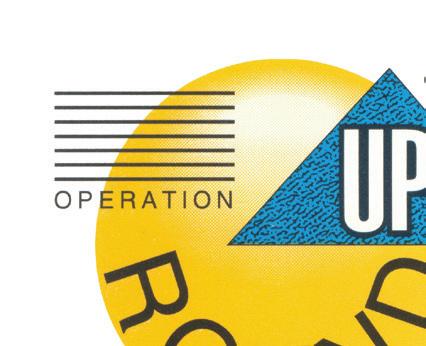


What is it?
Operation Round Up is a program that allows members to round up their monthly bills to fund projects benefiting community members in need.
Nine members serve on the board of directors for Glades Electric Charitable Trust, a 501(c)(3) nonprofit organization. Directors review applications and approve grants.










$13,000 of Operation Round Up funds were distributed to support individuals and nonprofit organizations in November 2023.
How does it work?
$138 55 cents to your neighbor in need. The average yearly contribution is $6 per member.



8,244 accounts participate in Operation Round Up or Operation Round Up Plus. Round Up Plus allows members to give even more, adding any set amount, $1 or more, to their bills each month.
Amount due: Power Bill UP ROUND 46%
Funds from Operation Round Up go right back into the communities we serve.




raised through Operation Round Up and Round Up Plus in October 2023.


Sign up for Operation Round Up in the SmartHub app, stop by the office or call Member Services at 863-946-6200.
Did you know?


$4,378.88























The participation rate it would take to raise more than $70,000 annually to support our communities. 75%
If you or a member you know needs financial assistance, please complete an application at: www.gladeselectric.com/community/operation-round-up.





From the rich maritime heritage of whaling towns to quaint island villages and grand seaside mansions of the Gilded Age, our small, comfortable ships can take you to the heart of New England’s most treasured destinations. Be welcomed back to your home away from home, where you can delight in the warm camaraderie of fellow guests and crew.












































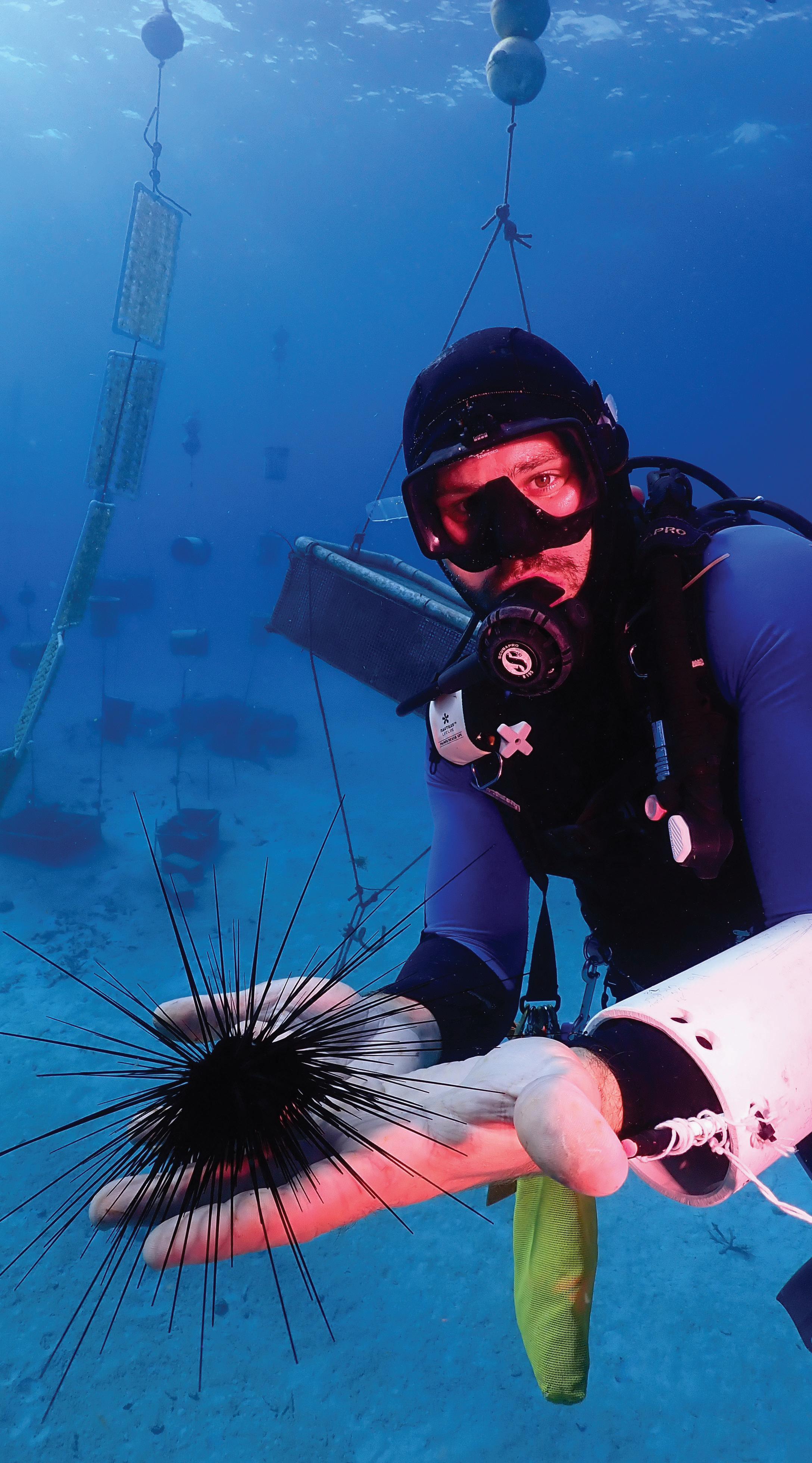
By Dan Eidsmoe
Beachcombers, scuba divers and snorkelers typically avoid urchins. If you step on one or accidentally bump into it, your skin can be punctured by the creature’s needle-like spines. Once under the skin, the spines are difficult to remove.
Florida Keys marine biologist Jim Brittsan, however, is excited by the round spiny creatures. As he explains, a healthy urchin population in the Caribbean is vital to the health of coral reefs.
Jim, 27, works with multiple coral restoration organizations throughout the Keys. Beginning as a selffunded project, he now has financial support from the state of Florida and is raising urchins in the wild with hopes of reintroducing them to Florida’s coral reef.
Urchins are important to the reefs because they eat algae. Out-of-control algae growth kills coral reefs by cutting off room for growth and diminishing the amount of sunlight and oxygen reaching the coral.

Jim says urchins are like underwater gardeners.
“When sea urchins consume


































algae, they create open spaces on the reef that can be colonized by new coral babies,” he says.
Algae growth and coral bleaching have decimated coral reefs. The Keys have lost 80% of their coral in the past 30 years. Many factors are believed to contribute to coral bleaching worldwide, including pollution, climate change, warming oceans and overfishing. In the Keys, water temperatures are frequently over 85 degrees in the summer. That high water temperature prompts algae growth that can smother coral and inhibit the settlement of coral larvae.
Jim, a Columbus, Ohio, native, is so optimistic about the prospects for raising sea urchins that he turned down scholarship opportunities for graduate studies in Puerto Rico and at Bowling Green University in Ohio.
Jim’s father, Mike, was the Columbus Zoo and Aquarium curator. As a student at Bowling Green University, Jim learned that everything in nature is interconnected.







































“If our oceans die, life in Ohio and landlocked states would also be adversely affected,” Jim says. “I knew coral reefs were in trouble, and I learned how important urchins were to the entire equation.”
Jim says the well-being of sea urchins has never been more important than now. Although once seen as a nuisance, the long-spined urchins are known as the greatest grazers of the Caribbean and caretakers of coral reefs.
The problem is, they are dying throughout the Caribbean. According to the National Park Service, long-spined sea urchins commonly live between the shoreline to depths over 100 feet. At low tide, they take shelter from waves in rock cavities. Although protected by the Florida Fish and Wildlife Conservation Commission, their numbers throughout the Keys have never been lower. Some scientists blame a microscopic, single-cell parasite for the die-off, which took hold in early 2022, but the resarch continues.
Jim describes one sea urchin species, Diadema antillarum, as a keystone species for Caribbean coral reefs. Before 1983, it was the most prevalent herbivore in the Caribbean. Today, it is nearly nonexistent.
“A diverse population of herbivores is important for maintaining a healthy balance between algae and coral on the reef and for supporting the many other organisms that rely on this ecosystem,” he says. “By restoring populations of different herbivorous species, we can help to support the health and resilience of Caribbean coral reefs.”
Jim hopes his urchin “babies” growing in an environment closely replicating the coral reef learn to eat algae off coral before being placed permanently into the wild. Every 15 to 30 days, he collects coral rubble covered in algae from the coral nurseries and puts it into the nursery with the baby urchins.
By grazing on the rubble, the young urchins learn to hide in the nooks







and crevices of the reef. They also eat everything in their path, not just the algae.
“The dead coral has many things growing on it,” Jim says. “In this setting, the urchins get a much more diverse diet of alga types. They also get bits of calcium carbonate from the rocks, which makes their spines hardier and increases spine density.”
In Jim’s nursery—the first of its kind in the Keys—coral trees and urchin shelters hang on monofilament lines tethered to the ocean floor and are held upright in the water by a buoy. The nursery integrates repurposed materials such as ice cream buckets, crates, ceiling tiles and Gatorade bottles. The cages, which Jim designs, are made from vinyl-coated wire and PVC frames. Sea water can pass through the boxes while protecting the growing urchins from fish predators.
“We hope to create a low-cost method to rear thousands of these herbivores,” he says. “A mariculture system like ours could be a game changer.”
With hopes high for the success of his urchin family, Jim is optimistic he may be able to leave coral reefs in a healthier place.
“With this project, I get the strong sense that I can be part of the solution rather than the problem,” he says.
Virtually visit the nursery in this three-minute video: bit.ly/sea_urchin_nursery.








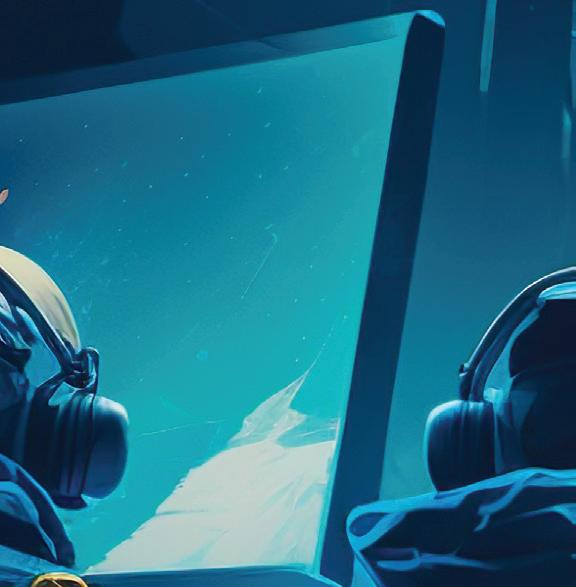



























Esports growth offers Florida students community and opportunity







By Drew Woolley
When Ryley Griffin arrived at the Florida Institute of Technology in 2018, he was excited to pursue a chemical engineering degree while playing lacrosse for the Division II school. It wasn’t long, however, before he discovered the rigor of his studies and the time he needed to dedicate to the team weren’t a good mix.




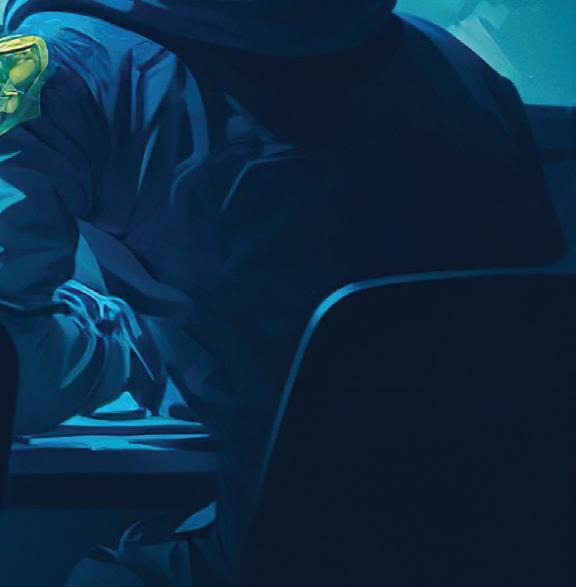


Still, Ryley knew he was competitive by nature. In 2019, another game captured his imagination.
“I realized I was going to go insane if I wasn’t part of a team or doing some kind of competition,” he says. “I was very in love with a game called League of Legends. I had played in internet cafe tournaments with my friends in high school. I decided to try and start a team with Florida Tech, who at the time was actually looking at doing esports.”
Florida Tech had just begun consulting

with Dana Hustedt, the director of esports at Grand View University in Iowa who helped build one of the country’s first collegiate esports programs in 2017. She provided a checklist of tasks that needed to be completed if Florida Tech wanted to create a robust program of its own.



In 2021, Florida Tech hired Dana as director of its esports program.
Since then, the program has assembled varsity and junior varsity teams for games such as League of Legends, Super Smash Bros., Rocket League and Valorant, while also building a welcoming community for noncompetitive gamers and establishing a two-story Esports Center on campus.
“Being a tech school, there’s always going to be that overlap of STEM students and video games,” Dana says. “It’s a way to engage their student population if you aren’t excited about regular sports or debate or other extracurriculars. This is a way that many students now relate with

gaming as a community factor.”




As a former student-athlete, Dana—who played varsity softball at Grand View University—often describes esports to newcomers in traditional sports terms. The playing field might differ, but many of the skills required are the same, from highlevel communication to rapid-fire decision making.
“Take a game where there are five players on a team,” she says. “Like basketball, they all have a position or a lane. Every one of them has their own unique skill set and fundamentals they need to do during the game. And the preparation that takes is very similar.”
Ryley found the same to be true when he first discovered League of Legends. In high school, he entered weekend competitions with friends at a local Microsoft store, where they played for






prizes, such as a new computer mouse.
“That’s where I fell in love with the competition,” he says. “I remember one day, we actually got to the finals, but we lost. None of us had any idea what we were doing, but we had a great time. I was there until 9:30 at night, so I got home, and my parents were like, ‘Where have you been?’ And I was like, ‘But I almost won.’”
After those amateur adventures, the Florida Tech team’s play was a harsh but welcome change of pace. Ryley says the

and there’s a software update for League of Legends. Now, my strategy is gone. Whatever champion I was going to play is out the window, and I have to figure something out in 30 minutes before we get into the game.”

transition to learning how to play a more organized game against far better players taught him the value of persistence. It also highlighted the importance of thinking on his feet, sometimes even more than when playing lacrosse.
“With traditional sports, you have all this training, and it almost becomes who can stick to a routine the longest and become the strongest from it,” he says. “But in esports, it’s so volatile. There are times when I’ve shown up to game day
In addition to cultivating adaptability, Florida Tech’s esports program is also designed to overlap with some of the university’s academic programs. The school’s Esports Center doubles as a home for the cybersecurity department, hosting classes, competitions and visits from prospective employers.
The esports program also works closely with the School of Behavior Analysis, with students observing verbal and nonverbal player behavior to monitor teams and offer workshops that help players develop as competitors and people.
“We don’t actually have a game design program or game animation as a major with us,” Dana says. “But we’ve used currently existing departments to see how can they also come into the gaming space with us. With the School of Behavior Analysis, the data that we’ve been collecting over the last three years hasn’t been taken anywhere else. So that’s really exciting in itself.”
Dana is excited to see the esports program serve as a gateway for visiting students who might not have known about the opportunities available at Florida

CLOCKWISE FROM ABOVE: Even for players who don’t compete on a team, the esports program can be an outlet for relieving the stresses of school and life. Florida Tech invested in a two-story, 5,800-squarefoot esports facility to give the program room to grow. A group of students gathers for a round of Super Smash Bros. PHOTOS COURTESY OF FLORIDA TECH ESPORTS
Tech. Drawn in by their interest in gaming, they might discover behavioral analysis only to find they also enjoy working in the same field with kids.
“Instead of working at a hospital, you might be able to get your research hours here through esports,” she says. “So that’s one really cool aspect that we can start to recruit people with. And it’s the same with cybersecurity. If your classes are taking place in a really cool gaming facility, that’s also a plus.”
Now a graduate student in Florida Tech’s chemical engineering program, Ryley says he routinely draws on his esports experiences as motivation in his academic work. As a researcher, esports has taught him to look for new solutions to a problem, even if everyone else approaches it the same way.
“You’re not going to get it right
the first time, and you’re probably not going to get it right the fifth time,” he says. “Even if someone else is doing it better than you right now, you can do it better than them later. It’s the same in school. You’ve got to allow yourself to not be thinking so rigidly about the world around you.”
Even if students don’t want to compete, participating in a robust esports program allows them to share their passion, connect with others and discover new opportunities, whether on campus or remotely.
“I think it gives those kids who don’t necessarily relate to traditional sports—who maybe don’t like watching football or soccer—it gives them something to be invested in and to have school spirit about that they might not normally have,” Ryley says. “I have Dana to thank because I’ve had some amazing years of my life because of the hard work she’s put in.”
While there are thousands of video game titles out there, a competitive game needs to have a certain amount of publisher backing so players know it will be around even as popular trends change. If you’re not game-savvy, the lineup can be confusing. Here are a few of the most popular:
League of Legends is a strategic multiplayer online battle set in a virtual arena. It’s a gaming staple, complete with diverse champions, complex strategies and a global following. The annual world championship keeps interest and participation high.
Combining soccer with rocket-powered cars, Rocket League has carved an esports niche. Gameplay is fast-paced and requires skill, with tournaments showcasing acrobatics and precise teamwork.
Nintendo’s iconic brawler features a roster of well-known gaming characters for competitors to use. Its gameplay is accessible for newcomers, but it has the depth needed to keep the attention of longtime players.
This tactical first-person shooter challenge requires precise gunplay and unique strategies. Its team-based action is great for tournaments and is an esports favorite.
Building on the success of its predecessor, Overwatch 2 includes diverse heroes and focused gameplay. It continues to be a favorite in esports. The game highlights the collaboration and skills of five-person competitive teams. The Overwatch League has franchises worldwide.





Graham Cracker Picnic Mix
¼ cup vegetable oil
¼ cup sugar
5 to 6 drops pink neon liquid food color
½ cup unpopped popcorn kernels

1 package mini pastel marshmallows
1 cup bear-shaped graham crackers
1 package white fudge-covered pretzels
1 cup mini cookies
In a large pot over medium heat, stir oil, sugar and food coloring. Stir in the popcorn kernels. Cover. Cook until popcorn begins to pop. Shake pot over heat until popping slows.
Remove pan from heat. Pour popcorn into a large bowl. Add marshmallows, graham crackers, pretzels and cookies. Toss lightly.
8 cups popped popcorn
2 tablespoons raspberry jam
3 tablespoons smooth peanut butter
½ cup white chocolate chips
¼ cup freeze-dried strawberries
¼ cup dried cranberries
In a large bowl, stir together popcorn and jam until evenly coated. Transfer to a parchment paper-lined baking sheet. In a double boiler over barely simmering water, add peanut butter and white chocolate chips. Cook, stirring occasionally, for 3 to 5 minutes, or until smooth and melted.
Drizzle peanut butter mixture over the popcorn mixture. Sprinkle with strawberries and cranberries.
Refrigerate for 10 minutes or until the peanut butter mixture is set. Break into pieces to serve. Store in an airtight container in the refrigerator for up to one week.
6 quarts popped popcorn
Olive oil cooking spray
1 cup grated Parmesan cheese
2 teaspoons garlic salt
2 teaspoons paprika
1 tablespoon Italian seasoning
Place popcorn in a large, sealable plastic container or a 2½-gallon plastic sealable bag.
Spray popcorn lightly with cooking spray. Sprinkle cheese, garlic salt, paprika and Italian seasoning over popcorn. Shake to distribute evenly.
12 cups unsalted, unbuttered, popped popcorn
4 cups mini marshmallows
2 tablespoons butter or light olive oil
½ teaspoon salt
1 tablespoon green food coloring
¼ teaspoon peppermint extract
1 cup green candy-coated chocolate candies
Place popcorn in a large mixing bowl. In a saucepan over medium heat, melt marshmallows, butter and salt. Stir occasionally until smooth. Remove from heat. Stir in food coloring and peppermint extract.
Toss marshmallow mixture with popcorn. Cool for 2 to 3 minutes or until cool enough to handle. Toss with chocolate candies.
Shape 3 tablespoons of popcorn mixture into a small cluster. Place on a wax paper-lined baking sheet. Repeat with the remaining popcorn mixture. Cool completely.
¼ cup freeze-dried strawberries, ground
6 cups popped popcorn
1 cup white chocolate chips, melted
In a small food processor or spice grinder, pulse freezedried strawberries until finely ground.
Place popcorn in a large bowl. Drizzle melted chocolate over the top. Toss until well-coated. Sprinkle evenly with ground strawberries. Toss until well-coated.
Scrape popcorn onto a large parchment paper-lined baking sheet, spreading into an even layer.
Let stand at room temperature for 30 to 60 minutes, or until chocolate is set and hardened. To serve, break into pieces.
5 cups popped popcorn
12 ounces white chocolate chips or chopped white chocolate
1 cup crushed hard candy peppermints
Cover a baking sheet with foil or wax paper. Set aside. Place popcorn in a large bowl. Set aside.
In a double boiler over barely simmering water, melt chocolate, stirring until smooth. Stir in crushed peppermints.
Pour the chocolate mixture over the popcorn mixture. Stir to coat. Spread onto prepared sheet. Cool completely.
When chocolate is cooled and set, break into chunks for serving. Store in an airtight container at room temperature.
8 cups popped popcorn
½ cup chopped toasted pecans
1⁄3 cup maple syrup
1 tablespoon bourbon
2 tablespoons butter
1 tablespoon orange zest
1 dash bitters
Place popcorn and pecans in a large bowl.
In a small saucepan over medium-high heat, combine maple syrup, bourbon and butter. Bring to a boil. Cook, swirling pan, for 3 to 5 minutes or until mixture thickens to corn syrup consistency. Stir in orange zest and bitters.
Drizzle maple syrup mixture over popcorn. Toss to evenly coat. Cool completely before serving.
Options: Substitute bourbon with rye or whiskey. For mocktail popcorn, substitute with nonalcoholic bourbon or whiskey.

My heart is heavy.
One of the true blessings of writing a column is the opportunity to share with you, my readers, not only what I see but what is on my heart. The two are often interconnected. As trite as it sounds, I feel like we are family.
In the wake of the most recent war atrocities, it’s challenging to keep my attention on things like photography and positive storytelling. Yet, even as I wade through the

emotions of these conflicts, I am reminded what a lifelong gift photography is, distracting me from deep and painful events while acting as a vehicle to share what I see and feel. For this, I am forever grateful.
Armed with a purpose, photography has always been a powerful communication tool. With it, we can shine light in dark places or quietly applaud acts of love and goodness. I believe both are necessary. While I truly admire the courage of my friends who risk their lives to show us the injustices and atrocities of war, I have chosen to celebrate light and those who reflect it.
Where there is light, there is hope. The new year is the perfect time to talk about seeing and being light. Whether
literal or metaphoric, light reveals and heals. Each of us chooses how we use light. With our cameras, as with our words, we can choose to focus on the good and lovely in our world or dwell on the dark, ugly and evil.
I attended a seminar where the speaker reminded his audience of the difference between a thermometer and a thermostat. One reads the temperature, and the other changes it, he challenged.
The late Agnes Baker Pilgrim—also known as Grandma Aggie, a Native American spiritual elder I wrote about a few years ago— said she talked to water, thanking it often. She insisted water hears us. I think light is similar. I know it has a voice. n
Show me the goodness of light, as it falls on mountains, fields, streams, rooftops, bedsheets or kitchen sinks. Or, as it springs forth from the heart in acts of kindness.
Email your best image (just one, please) with caption information, including an explanation of how it affects you, to GPH@pur.coop. We may share submissions on our website and social media channels.
How can rechargeable hearing aids that t inside your ear costs only $297 and be every bit as good as those that sell for $4,800 or more?
The answer: The MDHearing™ NEO uses the same kind of technology incorporated into hearing aids that cost thousands more at a small fraction of the price. Satis ed MDHearing customers agree: High-quality, digital, FDA-registered rechargeable hearing aids don’t have to cost a fortune. NEO is a medical-grade, digital, rechargeable hearing aid offering sophistication and high performance; and works right out of the box with no time consuming “adjustment” appointments. You can contact a licensed hearing specialist conveniently online or by phone — even after your purchase at no cost. No other company provides such extensive support. Now that you know... why pay more? PLUS... It fits inside your ear.

































Looking like a miniature aircraft carrier riding on massive tires, the swamp buggy crawls along a field edge smashing through brush and high weeds near Lake Okeechobee in south Florida.
Instead of jets, this flattop carries a deck festooned with old automobile seats where hunters sit in comfort. One deck below, crates contain excited dogs.
A 250-pound feral boar erupts from cover. Wanting to trap the animal alive, we release dogs to chase this tusked mammal through briar thickets and dense underbrush.
Domestic hogs first came to North America with early European explorers. In 1539, Spanish conquistador Hernando de Soto landed near Tampa, bringing a large herd of pigs to feed his troops. Some pigs escaped into the wild and multiplied.
Today, the pigs’ descendants number in the millions and populate more than 35 states, with the highest concentrations of feral hogs found in Texas, Florida, Louisiana and California.
Many people consider feral hogs among the most dangerous mammals in North America.
Bristling with razor-sharp tusks up to 3 inches long, a wild boar can inflict serious injuries. Leaner and more muscled than barnyard pigs, boars can weigh more than 500 pounds, but average between 100 and 300 pounds. A coarse hide covering a thick shield of hardened scar tissue draped over its head and bony shoulders protects its vital organs.
With armor, a bad disposition and few natural enemies, adult boars fear nothing—except dogs.
In a good spot, hunters release one to three strike dogs, such as curs, redbones or walker hounds. They alternate dogs during a hunting day. Strike dogs sniff out the pigs and chase them, nipping the hogs’ tail or back legs to make them stop, face the pack and fight.
Once strike dogs bay a pig, hunters send in a catch dog, typically a strong-jawed pit bull, often wearing a spiked collar and Kevlar vest for protection. The catch dog grabs an ear, snout, other

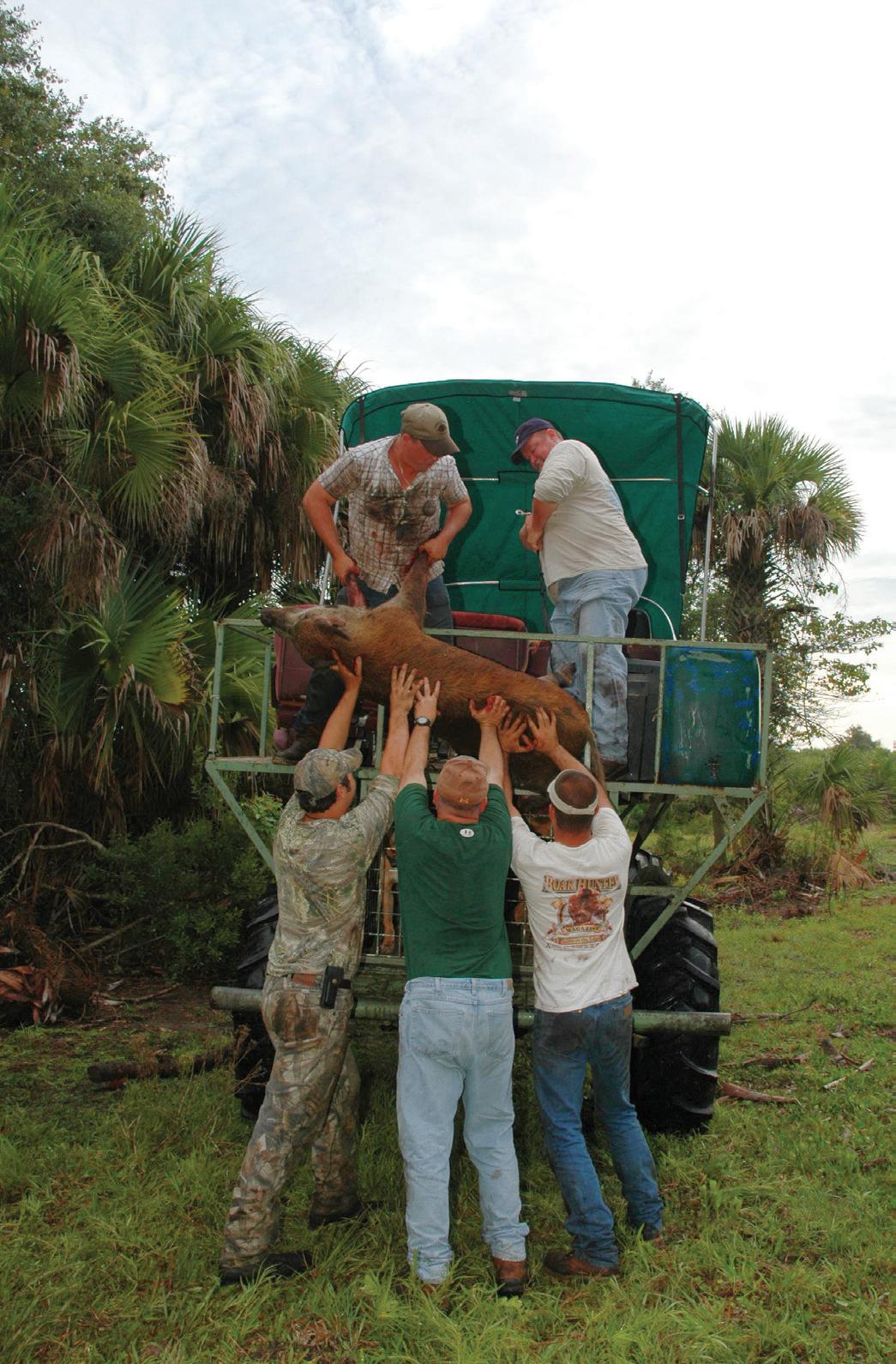
sensitive organ or whatever it can on an angry pig to immobilize it until the humans arrive.
After an exhilarating chase behind howling hounds and an adrenaline-pumping brawl at the bay, one or more hunters grabs the pig by its hind legs. This keeps it from moving and angles the porker’s head downward to prevent it from slashing people or dogs with its tusks.
With the pig held securely, someone kills it, customarily stabbing it with a large pig-sticker knife to avoid injuring any humans or dogs. Some people shoot the pigs with handguns.
Hogs populate every Florida county. The state allows hunters to hunt feral hogs all year on private lands. Some public properties allow people to shoot wild hogs as bonus game during other open seasons. The state even offers special hog-hunting opportunities on certain lands.
Because the highly prolific nonnative animals frequently destroy fences, eat crops and tear up wildlife habitat, many landowners welcome hog hunters onto their properties.
For more on Florida hog hunting, visit myfwc.com/hunting/ wild-hog.

John N. Felsher is a freelance writer, broadcaster, photographer and editor. An avid sportsman, he’s written more than 3,500 articles for more than 170 different magazines on a wide variety of outdoor topics. He also hosts an outdoor tips show for WAVH-FM Talk 106.5 in Mobile, Alabama. Contact him at j.felsher@hotmail.com or through Facebook.



Mighty Conifer Knife at an Impossible
What Stauer Clients Are Saying About Our Knives
“Outstanding knife of high quality and a great price. I now have a number of your great cutlery in my growing collection!”
—
Robert F., Richardson, TX

e know you. You’re not interested in everyday, run-of-themill, common cutlery. You want something with a story, a unique feature that you can brag about. We’ve got just the thing for you. Our Mighty Conifer Knife is a unique tool with a Damascus steel blade and a handle crafted from an enhanced and stabilized natural pinecone. While our competitors are charging hundreds for similar knives, we’re offering the Mighty Conifer for JUST $99! That’s what we call our Stauer Impossible Price.

$99 Impossible Price

person who wants to stand out. CALL NOW! If you’re one of the first 700 587 callers for this ad, we’ll throw in a pair of Stauer 8x21 Compact Binoculars — a $99 value — ABSOLUTELY FREE!
Satisfaction guaranteed or your money back!
Knife Specifications:
Join more than 389,000 sharp people who collect stauer knives EXCLUSIVE FREE
Each pinecone — and therefore, each knife — has its own unique characteristics. And the back of the handle features hand tooling, a further demonstration of each piece’s individual nature.
The blade is nothing to scoff at either. Constructed of Damascus steel, a modern reworking of the legendary steel forged by ancient swordsmiths, this nearly 5-inch blade features 256 layers of steel that have been folded on top of each other to increase its durability. Our competitors are charging hundreds for boring, run-of-themill knives with no features worth bragging about. We’re asking JUST $99 for a knife unlike any you’ve seen before!
With its full-tang construction and high-quality genuine leather sheath, the Mighty Conifer Knife is the perfect blade for the
• 9 1/2" overall length. Full-tang construction
• Damascus steel blade and natural pinecone handle
• Genuine leather sheath
Mighty Conifer Knife
$299 $99* + S&P Save $200
*You must use Insider Offer Code: MCK145-01 to get this price.

Stauer 8x21 Compact Binoculars a $99 value with your purchase


California residents please call regarding Proposition 65 regulations before purchasing this product.
1-800-333-2045
Your Insider Offer Code: MCK145-01



All ages can find something new and exciting around every corner of the state. Filled with rich history, abundant natural beauty and diverse events all year, Florida has something fun for everyone.
January 1-16
First City Lights Festival
Navigate the eclectic historic district voted Florida’s Greatest Place as you experience live street performances, caroling in the streets and Winterfest Trolley Tours.
www.downtownpensacola.com; 850-434-5371
January 6 and 20
An Evening Under the Stars
Big Lagoon State Park, along with the Escambia Amateur Astronomer Association, invites you to spend an evening gazing at the skies. Clear skies permitting, telescopes and binoculars are set up to capture views of the moon, planets and other celestial objects. All participants must enter the park before sunset.
www.floridastateparks.org; 850-492-1595

January 13
Paws for a Cause
This dog walk to Pigeon Key benefits the Domestic Abuse Shelter of the Florida Keys. Registration begins at 8:15 a.m. at the beginning of the old 7-Mile Bridge. The walk starts at 9 a.m. Brunch is served on Pigeon Key. Bring your family and dog for a beautiful 4.4-mile walk.
305-849-6236
January 13
40th Annual Art Under the Oaks


January 6-7
Florida Keys Celtic Festival
This festival brings the rich cultural heritage of the Celtic nations to the heart of the Florida Keys. This family-friendly event features world-class musicians, performers, athletes, food, beer, and Celtic and Keys vendors. Children can enjoy arts and crafts, along with Highland Games events. This event is open 10 a.m. to 7 p.m. Saturday and 11 a.m. to 5 p.m. Sunday.
floridakeyscelticfestival.com; 850-529-0699

View fine art, original crafts and live entertainment in the San Pedro Church gardens. Enjoy refreshments, homemade bake sale goodies and raffles from 9 a.m. to 4 p.m. Admission is free, but onsite parking is $5. www.artundertheoaks.com; 305-852-5372, ext. 3








January 13-14
18th Annual Florida Keys Seafood Festival
Seafood and music combine yet again for this year’s festival at Bayview Park. From stone crabs and conch fritters to classic rock, this year’s festival brings timeless tunes and classic hits to the outdoor stage. Vendors are available for shopping, and a children’s area includes bounce houses and face painting. The $10 admission is good for both days. Children younger than 12 get in free.
floridakeysseafoodfestival.com; 305-743-0294


January 20
Kids and Kritters Mardi Gras Parade
This family-friendly Mardi Gras event is a walking procession for people and pets. The event begins at 1:30 p.m. in the Casino Beach parking lot with a pre-parade dance show. The parade begins at 2 p.m. www.pensacolabeachmardigras.com; 850-748-6878
January 21
12th Annual Tea
Enjoy an afternoon of dining on tea sandwiches, fruit breads and decadent desserts. Join the fun with the Country Girl Dress Up contest. Doors open at 1 p.m. and tea hours are 2 to 4 p.m. Tickets are $25 and can be bought at the Caladium Arts and Crafts Co-Operative, 123 Interlake Blvd. www.caladiumarts.org; 863-699-5940
January 26-27
Trash and Treasure Sale


The St. James Council of Catholic Women sponsors its annual Trash and Treasure Sale at the church’s Social Hall, 3380 Placid View Drive. The sale is one of the largest in the area with clothing, housewares, furniture, tools and fishing equipment included. Doors open at 8 a.m. and close at 2 p.m. Friday and 1 p.m. Saturday. www.stjameschurchlp.com; 863-465-3215
January 27
Pops in the Park
The Florida Keys Community Concert Band invites you to attend this free band concert in Peace Park. January’s event is Looney Tunes—Heroes and Villains. Pack a picnic basket and blanket or chairs, and load up the family and furry friends for this night of music. keyscommunityconcertband.org; 305-294-1123


January 15, 22 and 29
Florida Keys Concert Series


Delirium Musicum is a self-conducted, ethnically diverse chamber orchestra from Los Angeles composed of some of classical music’s top up-and-coming young artists. Other dates include January 22 with cellist Zlatomir Fung and January 29 with Shelest Piano Duo. Concerts start at 7:30 p.m. in the Marathon High School auditorium. www.floridakeysconcerts.com; 800-324-6982
January 27-28
Peace River Pro Rodeo Classic
Rodeo fans come to the Heartland of Florida and watch professional cowboys and cowgirls from across the nation compete. Gates open at 5 p.m. Saturday and noon Sunday at Hardee County Cattlemen’s Arena. Food and clothing vendors are onsite. www.peaceriverprorodeo.com; 863-773-4132



Want to share a family-friendly event with the readers of Florida Currents? Send details in an attached Word document (no PDFs, please)—in the format shown on this page—to info@floridacurrents.com. Include the date, town, times and a way for readers to register or get more information. Make sure to submit the item at least 60 days before the event (due to press deadline). If you own rights to a print-quality photo promoting your event— perhaps from a past year—include it with photo credit information.




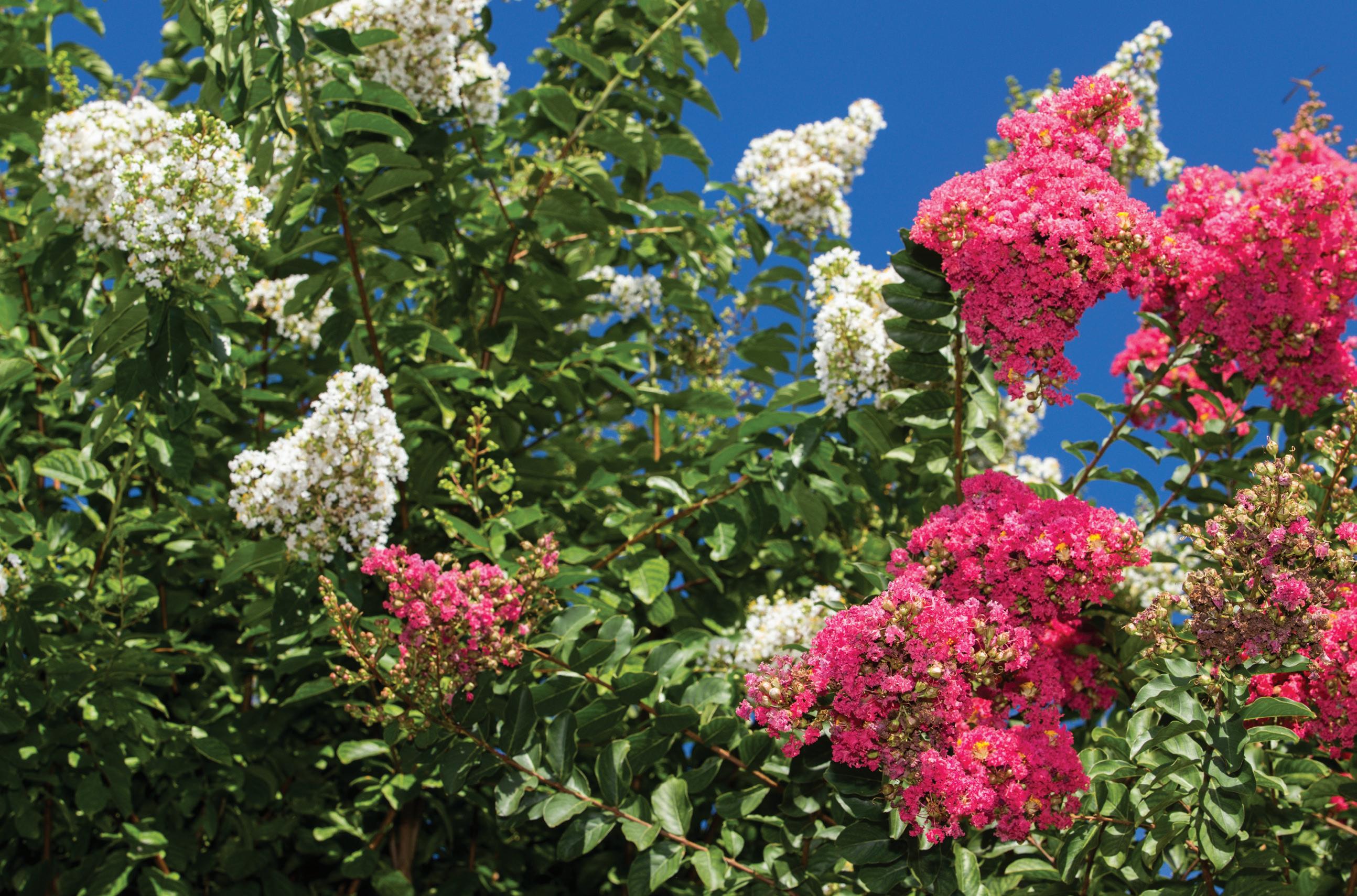

Crapemyrtle is a versatile, drought-tolerant tree that produces dazzling blooms all summer long.
The tree is also a living sculpture during the winter, adding form and texture to the landscape. Late winter is the optimal time to prune crapemyrtles.
It’s important you know how to prune correctly so you can avoid topping—a practice commonly known as “crape murder.”
To properly prune crapemyrtles, use the following techniques:
• Remove suckers (small sprouts that develop along main stems or roots).
• Remove crossed, damaged or diseased branches. For crossed branches, remove the weaker of the two limbs that are crossing or rubbing.
Unfortunately, many homeowners and landscape professionals prune crapemyrtle trees too severely.
Topping can damage the tree and results in a “witch’s broom” appearance. Following this, the tree is no longer in proportion. Although topping may result in larger blooms, the flowers grow on thinner, weaker branches that droop and may even break. Topping can also shorten the life of the tree.
If you want to rehabilitate a “murdered” crapemyrtle, try one of the following options:
• Choose the strongest two sprouts from each stub, and remove the rest. This encourages remaining sprouts to grow stronger and opens the canopy of the tree. If you follow this procedure for a few seasons, the tree should improve in health and appearance.
• Cut the tree back to between 1 to 2 inches of the ground while the tree is dormant. After two to three weeks of growth, select three to five of the most vigorous new shoots on each trunk and remove all others. Remove any new shoots that emerge later. Within three to five years, you should again have a natural-looking crapemyrtle.
Spread the word to help eliminate crape murder. Use proper pruning techniques on your own trees or ask your yard maintenance professionals about their pruning techniques. Choose an appropriately sized plant for your site and prune sparingly to maintain beautiful crapemyrtles in your yard.
The UF/IFAS Florida Master Gardener Volunteer Program focuses on educating citizens about the science-based landscape and gardening information developed by the University of Florida. These volunteers share this knowledge with people in their communities to help conserve water, protect natural resources, and improve the lives of Florida residents. Visit UF/IFAS Gardening Solutions at gardeningsolutions.ifas. ufl.edu for more information on gardening in Florida.
Glades Electric Cooperative and Conexon continue to achieve major milestones in the construction of a high-speed fiber network to serve all Glades Electric members.
Two fiber huts were installed October 31 to house network connectivity components for members served by the Ortona and Morgan Henderson substations.
Each hut arrives at the installation site on a flatbed trailer. The hut is removed from the trailer by a crane and carefully placed on a concrete pad.
A fiber hut to serve our Drake Substation area in Hendry County was installed in July. The Drake fiber hut serves
members in Montura.
With splicing completed for the Montura circuit, Conexon was expected to begin connecting fiber to homes in Montura by January 2024.
As of December 1, more than 260 miles of fiber have been installed for Glades Electric’s fiber network. This marks nearly 10% of the total fiber to be built.
Work continues in the Ortona, Morgan Henderson, Lakeport, West Clewiston and Cowbone substation areas to prepare GEC infrastructer for fiber installation.
For information on the timeline for service availability at your location, visit www.conexonconnect.com.





By McKenzie Miller
Three Glades Electric Cooperative employees spent October 16 at LaBelle Middle School in Sandra Di Liegghio’s seventh grade science classes teaching students about electricity.
Representing Glades Electric was Safety Manager Kyle Altman, Journeyman Lineman Blake Prescott and Journey Meter Tech Donnie Murphy. They used the co-op’s Safety City demonstration model to show students the dangers that can come from interfering with electrical equipment and wires, as well as the different transfers of energy.
For the 10 days prior to the presentation, seventh graders taking the science class learned about different types of energy, where it comes from, how it’s made and used, how to investigate and describe the transformation of energy from one form to another, and that energy cannot be created or destroyed—only changed from one form to another.
“The students were able to discuss the interesting information about electricity in the handouts provided to us by GEC,”



Sandra says. “They were very interested in the safety aspect. The students were also able to learn about a possible career path that they may consider in the future.”
Taking the skills and knowledge Glades Electric employees use daily and educating youth is important to GEC. Safety measures that should be taken by anyone in a situation where electricity is involved is not often taught or known at a young age. Having the opportunity to inform the students about how to approach and react in such situations is crucial.
Instead of just being taught what not to do, GEC employees can dive deeper into the hows and whys of dealing with electricity.
We are thankful for employees who love to educate youth and take the time out of their busy schedules to do so.
Safety City day at LaBelle Middle School was successful, and GEC looks forward to future opportunities to spread knowledge of electricity and safety throughout its communities.




Trustee seats for District 2, Hendry County; District 6, Highlands Park; and District 8, Lake Josephine, are up for election this spring. Members seeking a nomination by petition must submit signatures by January 12.
For eligibility requirements and more details, visit www.gladeselectric.com/about-us/board-oftrustees. For more information, email communications@gladeselectric.com.
This year’s elections take place in March and April by electronic voting through SmartHub or by mail-in ballot. The 2024 annual meeting is scheduled for April 11. Look for complete voting details in our February issue of Florida Currents.
Glades Electric Cooperative offers a membership hold option for seasonal residents who anticipate a return to GEC’s system within nine months of service disconnection. Members can reduce paperwork required to reactivate membership. Upon disconnecting your service this spring, let a member service representative know you plan to restart service within nine months to use this hold option. Contact member services at 863-946-6200 to learn more about the terms and requirements of the membership hold option.
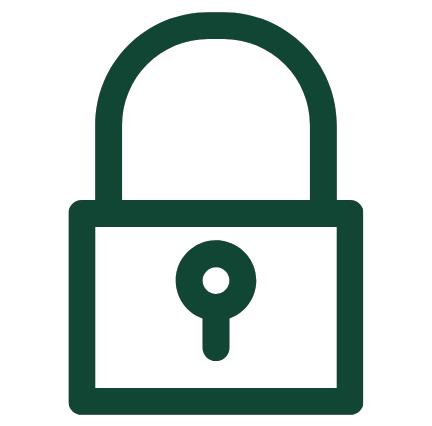

If you have gated access to your property, be sure you have a GEC lock or your gate code is on record with us. Glades Electric employees must be able to access the equipment 24/7 to respond to outages and maintain our equipment.
Membership agreements require power system equipment to always be accessible by GEC personnel. Call 863-946-6200 or use SmartHub to request a lock or share your gate code.
The SmartHub redesign puts your use and payment details front and center for fast, easy access while the simplified menu structure makes navigating the site a breeze. Visit gladesec.smarthub.coop/Login.html to see the new design and access SmartHub for 24/7 account management.



Deadline for Youth Tour applications is January 11
Juniors, don’t miss out on an opportunity for an all-expenses-paid trip from June 16-21 to Washington, D.C.
Scan the QR code for a link to the application, or visit www.gladeselectric.com/community/student-programs-information. Applications are due January 11.



Deadline for college scholarship applications is February 22
Seniors, if you’re planning to attend college, apply for one of the Glades Electric Educational Foundation $4,000 scholarships for students served by Glades Electric Cooperative.


Scan the QR code for a link to the application, or visit www.gladeselectric.com/community/student-programs-information. Applications are due February 22. For more information, email communications@gladeselectric.com.

Sometimes, there are no words to describe your day—good or bad. Other times, days are long and tiring, so who wants to spend energy writing at the end of the night?
However, if you’re set on journaling in 2024, there are still options that can turn that dread into excitement.
Try taking writing out of the mix. Journaling doesn’t have to include words. Focus on visuals: drawing or doodles, graphs, daily Polaroids or creating pixels.
Documenting the year in pixels has been a favorite among bullet journaling in the past few years. Follow these six steps to set yourself up for an easy year of journaling:
• Find a piece of paper. This could be within a journal or a standalone piece. Keep it where you can find it at the end of the day.
• Choose five to 10 colors from your set of colored pencils, pens or markers. The medium you choose depends on how vibrant you want your pixels to be. Pens and markers tend to be brighter.
• On your piece of paper, draw a horizontal line at the top of the paper and a vertical line along the left side. Draw an additional 31 horizontal lines going down the page and 12 vertical lines across the page, creating little squares that become pixels as they

month above the columns. Along the left side, number the rows one to 31 downward.
• To the right side of the page, create a key. Match a color with an emotion or state of mind you were in that day.
• List emotions or states of mind you might feel throughout the year. Some useful ones are: good, happy, normal, routine, productive, lazy, unmotivated, angry and sad. To the left of these words, assign a color. You can choose as few or as many colors as you would like for your year.

SHE FOUGHT FOR HER COUNTRY. IT’S OUR DUTY TO FIGHT FOR HER.

Wounded Warrior Project ® long-term support programs provide these brave men and women whatever they need to continue their fight for independence. At no cost. For life. Help us help more of these warriors in their new life-long battle. Find out what you can do at fi ndWWP.org.






























































863-946-6200 (member services) 844-201-7203 (24-hour phone payments) www.gladeselectric.com
7 a.m. to 6 p.m. Monday through Thursday
26733 U.S. Hwy. 27
P.O. Box 519
Moore Haven, FL 33471
214 SR 70 W. Lake Placid, FL 33852
Via the SmartHub app
~ 863-946-6200 (24/7 outage reporting)
Please have your account number ready.
John “Jack” Coxe, President, District 8 Lake Josephine, 863-414-3833
Lee Henderson, Vice President, District 6 Highlands Park, 863-633-9281
Shannon Hall, Secretary/Treasurer, District 4 Lakeport and Brighton, 863-946-3242
Donnie Lundy, Trustee, District 1 Moore Haven, 863-946-0402
Barney Goodman, Trustee, District 2 Hendry County, 561-414-8737
Mike Pressley, Trustee, District 3 Ortona and Palmdale, 863-673-9158
Brad Oxer, Trustee, District 5 Venus and Hicoria, 863-441-1866
Fred Tagtmeier, Trustee, District 7 Lorida, 863-214-4994
Angela Hodges, Trustee, District 9 Okeechobee, 863-801-3140
The Board’s next meeting is at 9 a.m. January 25 at the Moore Haven Board Room. Any changes will be posted in the lobby of both district offices.
Jeff Brewington, CEO
Courtney Brown, Chief Personnel Officer
Jennifer Koukos, Chief Communications Officer
Jennifer Manning, Chief Financial Officer
Michael Roberge, Chief Operations Officer
It took 11 years—2010 through 2020—for our system to grow by 1,000 meters. It appears our next 1,000meter jump will be achieved just three years later at the end of 2023, with our next 1,000 likely to come by the end of 2025.
Banyan Village on Highway 80 between Clewiston and LaBelle has more than 200 active homesites with more than 4,000 sites platted. Word is out about a 2,000-homesite plan at State Route 78 and County Road 721 in Glades County, a 700-unit manufactured home site on SR 70 West in Highlands County and another 4,500-homesite plan north of Okeechobee. All this without mention of Airglades.
We are at a tipping point.

Our 2024 strategic work plan and budget takes that into account with a more forward look planning for this anticipated growth and the need to grow our workforce to keep up.
Inflation, energy policy and supply chain issues continue to hamper us.
Even so, we begin 2024 with a rate of $162.50 for the first 1,000 residential kilowatthours, which is 1.5% lower than where we started in 2023.
As always, we will strive to reduce rates as costs allow while maintaining safe and reliable service.
The big news is some of our members are anticipated to have high-speed internet through Connect, Powered by Glades Electric this month. We look forward to celebrating our first connection.
This is a life changer for members, and it was only made possible through the support of our members and local stakeholders, just like the pioneers who brought electricity to the area in 1945.
This project is expected to take all of 2024 and 2025 to completion.
Be patient. You will not be left behind. We will get to you. Remember, it took nearly 80 years to build out our electric system.
Fiber will be at your door in three years or less. That’s quite an achievement. Visit www.conexonconnect.com to sign up. You’ll receive an email to schedule your installation when service is available in your area.
2024 is looking good for your cooperative. I hope you enjoy a prosperous new year, too!
